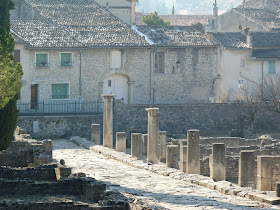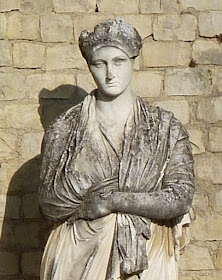My blog friend Elizabeth set me thinking when she made a comment on the post about the Roman Empress Sabine. While most of the other reactions voiced admiration for Sabine, she was alone in saying that she came across to her as manipulative. And as I know that
Elizabeth is a woman of great sensitivity, I found this both astute and thought-provoking as it leads to the question of character: both how we each judge the characters of others in life, and how we read and write them.
I described Sabine as a strong, independent-minded woman from her face as captured so beautifully in stone and from the little I’d found out about her. And while most of us would consider those worthy character traits, it’s also true that you can have too much of a good thing.
Elizabeth is quite right: Sabine could very well have been manipulative. The refusal to have any children by her husband probably bears that out; “strong woman” does not automatically equate to “good woman” or “woman who always behaves well”. As with any virtue, pushed too far strength can become unlikeable – a harridan of a boss, a difficult member of the family, for example.
Largely, how we react to people and characters in fiction is to do with our own internal scale, experience with similar characters and perception of our own strengths and weaknesses. This was brought home yet again to me when I did a little talk for a book group the other week. Some readers engage with one character in a novel, others see the book very differently. Different aspects appeal to different readers. It always happens.

The most forthright discussions I ever have are when a reader tells me she or he hated a character - and by extension, the novel – because the way they behaved was so terrible, or annoying or cruel, while I had put all the wrong emphasis on which was the “good” character which the “bad”. And I have to explain that the very complexity they dislike is the point of book: the writer is trying to use characters to reflect the complexities of life. It's possible for a sympathetic character to do something wrong without that incident making them a bad person through and through. Unpleasant characters can have redeeming features. Often our reaction to these specific events strikes a chord with a personal memory.
So I went back to find out some more about Sabine. She married Hadrian in 100 AD. According to some records she was only 13 which was on the young side even for the ancient Romans, and she was the great-niece of Hadrian’s guardian, the Emperor Trajan.

Now Hadrian gets a good press as Emperor. In addition to his military interests, he was passionate about architecture and construction. He ruled over a vast empire that was stable, with a strong economy, and he travelled to many of its outposts. To the people, he was an admired and popular figure.
But behind closed doors there’s another side to Hadrian. His marriage to Sabine was purely political, a disastrous union on the personal level. Young Sabine was his closest unmarried female relative, thus increasing the family’s powerbase, but there was never any love between them. The relationship was so antagonistic that he said he would have divorced her if he were not Emperor.
But what was the cause of this hostility and unhappiness on both sides? Well, a little more research reveals historians of the time freely admitting Hadrian’s “Hellenistic” tendencies – a love of all things Greek. For Hadrian, this extended to homosexuality and a particular attraction to young boys.
Hadrian’s page boy Antinous became “the slave of his unlawful pleasure” and “a loathsome instrument of his master’s lust”. When this youth was found drowned in the Nile while the court was in
Egypt, his death sent Hadrian into a torment of grief. He made Antinous a deity, as it was the highest accolade he could bestow.
Yet against all this must be weighed the acceptance that Hadrian was no monster by the standards of the times. There’s no place for revisionism here: Hadrian was a great admirer of all things Greek, and among the intellectuals of ancient Greece the love between a man and a boy was considered the purest form of love. We can contrast his actions and the acceptance of them with the mores of the world now, but we cannot condemn him absolutely on our terms.
However, if we consider Sabine’s position now, what we can say is that her attitude to Hadrian might have made her a woman ahead of her time. But there again, the historians were men who gave a man’s account excusing Hadrian’s proclivities. They don’t record the effect on the woman he married, or the feelings of any of the women expected to understand and excuse the Hellenic ideal. Or indeed, the boys who caught his eye. All we can do is imagine from our own perspective.
You wonder, too, lost in admiration at the artistry involved, how much of this was in the mind of the sculptor when he created the statue of the Empress Sabine, and what an achievement it was to capture a tantalising essence of the woman that can still intrigue after two thousand years.
PS. The bust pictured isn’t Sabine. I found her in a junk shop years ago and reckon she started out as a garden ornament. But she fits into an alcove and I like her presence.
Elizabeth Young’s blog is
here.







_01%5B1%5D.jpg)















